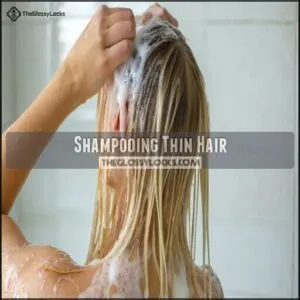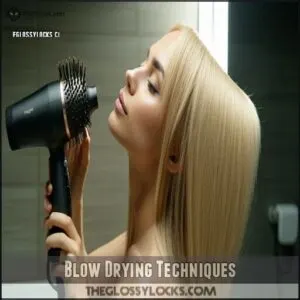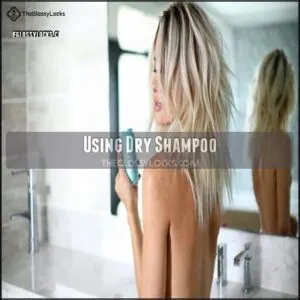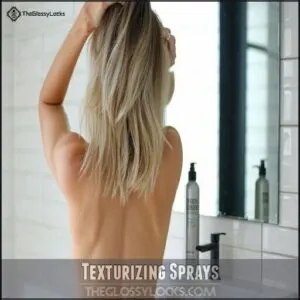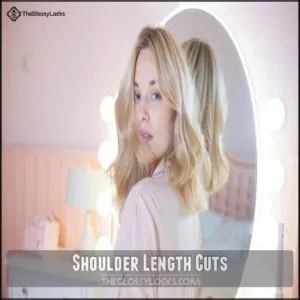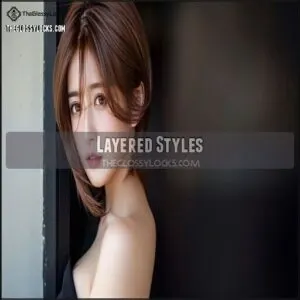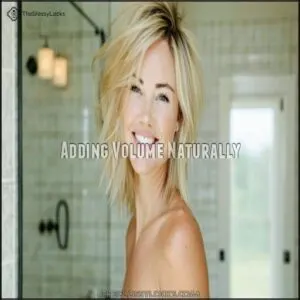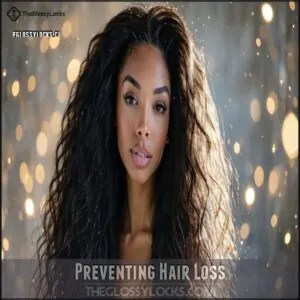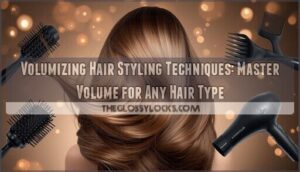This site is supported by our readers. We may earn a commission, at no cost to you, if you purchase through links.
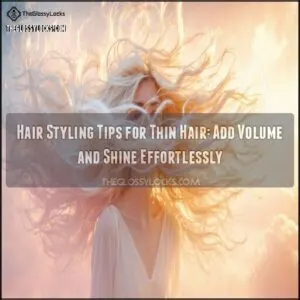
Start with a volumizing shampoo—it’s like giving your roots a pep talk.
Skip heavy conditioners that weigh hair down; instead, apply a light one just to the ends.
When blow-drying, flip your head upside-down to boost lift at the roots.
Dry shampoo isn’t just for lazy days—it’s a secret weapon for adding texture and grip.
Layered cuts or bobs create instant fullness, and a dash of texturizing spray can work wonders for volume.
Want more tricks?
There’s plenty more to explore for gorgeous, fuller hair.
Table Of Contents
Key Takeaways
- Use volumizing shampoo and lightweight conditioner to keep your hair fresh and prevent weighing it down.
- Blow-dry upside-down and use dry shampoo or texturizing spray to boost volume and texture.
- Try layered, bob, or pixie cuts to create the illusion of thickness and fuller hair.
- Reduce heat styling, and nourish your hair with a balanced diet, scalp massages, and regular trims.
Shampooing Thin Hair
Shampooing thin hair requires the right products and a light touch to avoid weighing it down.
Use gentle, volumizing shampoos to cleanse and lift thin hair without weighing it down for a fresh, full look.
By choosing volumizing formulas and applying them strategically, you’ll keep your hair looking fresh and full of life.
Choosing Right Shampoo
Choosing the right shampoo can make thin hair feel fuller. Look for lightweight formulas that cleanse without weighing hair down. Opt for volumizing shampoos with ingredients like biotin or keratin.
Avoid heavy moisturizers that flatten fine hair. For those seeking to enhance their hair’s volume, exploring options for volumizing shampoo thin can be beneficial.
Consider these tips:
- Match shampoo to your scalp type.
- Use sulfate-free options.
- Limit clarifying frequency.
- Try shampoos boosting hair volume.
Applying Shampoo Correctly
When washing thin hair, focus on your scalp, as that’s where oil and buildup collect. Use a small product amount—about a dime-sized drop—so you don’t overwhelm fine hair.
Massage gently with your fingertips to boost circulation. Stick to lukewarm water; hot water can dry out strands.
Rinse thoroughly to avoid residue that might weigh your hair down. Some shampoos contain ingredients to plump individual strands for a thicker appearance, and using the right shampoo can help with hair care, and promote healthy hair.
Conditioning Techniques
After shampooing, focus on fine hair care by applying lightweight conditioners only to the mid-lengths and ends.
Avoiding roots prevents flatness and greasiness. For thin hair solutions, scrunching hair with conditioner helps improve texture while air-drying.
Conditioner overuse can weigh hair down, so adjust usage sparingly. These fine hair tips guarantee volume and softness without sacrificing thickness.
Clarifying Shampoo Usage
A clarifying shampoo is your secret weapon for thin hair.
Use it weekly to tackle product buildup without color stripping.
Here’s how to maximize its benefits:
- Apply sparingly to avoid over-cleansing.
- Focus on roots for deep hair cleansing.
- Rinse thoroughly for freshness.
- Alternate with regular shampoo to maintain balance.
- Adjust frequency for your hair care needs to achieve the best results with your regular shampoo and maintain a healthy balance.
Styling Thin Hair
Styling thin hair doesn’t have to be a daily struggle if you know the right tricks.
With a few smart techniques, like blow-drying for lift or using texturizing sprays, you can create effortless volume and movement.
Blow Drying Techniques
Flip your head upside-down while blow-drying to lift roots and add instant volume.
Use a heat protectant before starting, then grab a round brush to shape and smooth thin hair styles.
Using the right tool is key, so consider a specialized brush for thin hair.
Finish with a cool shot to lock in the lift.
For softer, natural waves, attach a diffuser.
These volumizing styling tips make blowdry sessions effortless and effective!
Using Dry Shampoo
After blow-drying, grab your dry shampoo to keep things fresh.
For thin hair, spray at the roots, holding the can 6 inches away. Let it sit a minute for oil absorption, then massage gently for a volume-boosting effect.
It’s like a quick shower in a bottle, minus the water! Avoid overuse to prevent residue buildup while revitalizing hair effortlessly.
Texturizing Sprays
If dry shampoo’s your go-to, texturizing spray is its fun, stylish cousin. It’s perfect for thin hair, adding lift and texture without weighing strands down.
Spray application matters—mist lightly for a natural finish. Many users find spray options for thin hair particularly effective.
Here’s how to use it:
- Focus on mid-lengths and ends.
- Avoid sticky roots.
- Reactivate with moisture.
- Check product ingredients for a volume boost.
Haircut Styles
The right haircut can make thin hair look fuller and more vibrant without extra effort.
From shoulder-length styles to pixie cuts, choosing a shape that suits your hair type and face can work wonders.
Shoulder Length Cuts
Shoulder-length cuts are among the best haircuts for thin hair, balancing volume and easy maintenance.
They suit most face shapes and hair textures, offering versatile layering options to create fullness.
Pairing this length with volumizing techniques, like blow-drying upwards, enhances body.
These hairstyles for fine hair are perfect for styling fine hair daily without overwhelming your routine.
Layered Styles
If shoulder-length cuts create fullness, layered styles take it up a notch.
A layered bob or shag layers can add movement and dimension, making thin hair look thicker.
Point cutting and dry cutting techniques guarantee precision, especially for fine hair.
Choose layers that suit your face shape—soft layers work wonders for volume, offering some of the best haircuts for thin hair, with layered styles that create fullness.
Pixie Cuts
Looking for the best haircuts for thin hair? A pixie cut with choppy layers is a game-changer.
A pixie cut with choppy layers adds bold texture and effortless volume, making it a perfect choice for thin hair.
It adds texture and thin hair volume while being low-maintenance. Play with styling products for spiky or tousled looks, and choose bottleneck bangs to frame your face shape.
With proper maintenance tips and bold color options, this fine hair styling choice shines. Patience is key when considering growing out a pixie.
Bob Styles
An angled bob is one of the best haircuts for thin hair, offering sharp lines that create the illusion of volume.
For even more lift, try a stacked bob with rounded layers or a choppy bob for added texture.
A blunt bob works wonders for chin-length styles, while a graduated bob adds dimension.
These haircuts for volume are game-changers!
Maintaining Hair Health
Keeping your hair healthy is the foundation for achieving volume and shine, even with thin hair.
By focusing on simple habits like regular trims, scalp care, and a nutrient-rich diet, you’ll set your strands up for success.
Diet for Hair Growth
Strong hair starts in the kitchen! Your diet plays a big role in hair growth and scalp health.
Focus on these food choices for healthier hair follicles:
- Protein-rich foods like eggs, chicken, and lentils.
- Omega-3s from salmon or walnuts.
- Vitamin-packed greens like spinach.
- Zinc-rich options like oysters.
Small dietary changes, big hair benefits!
Regular Haircuts
Regular haircuts are your secret weapon for thin hair.
Trimming every 6-8 weeks prevents split ends, keeps your shape sharp, and promotes healthy growth.
Opt for the best haircuts for thin hair, like layered bobs or pixie cuts, to add volume and style refresh.
Remember, skipping trims leads to damage control headaches—so snip away for lasting bounce and confidence!
Scalp Massages
After trimming split ends, give your scalp some love with DIY massages.
They improve circulation benefits, promoting a hair volume boost.
Use your fingertips, massage tools, or oil infusions like coconut or rosemary oil for added nourishment.
Increased blood circulation to the scalp can further enhance these benefits.
Aim for two to three sessions weekly.
It’s a relaxing way to complement hair thickening products and other hair styling tips for thin hair!
Vitamin Supplements
After scalp massages boost circulation, support hair health with vitamin supplements.
Biotin benefits hair growth and thickness, while addressing iron deficiency strengthens strands.
Vitamin D and zinc intake also promote healthier follicles.
Balance is key—too many nutrients can cause supplement side-effects.
Stick to a well-rounded diet and consult a doctor before adding extras for ideal hair thickness and shine.
Adding Volume Naturally
You don’t need fancy tools or endless products to give your hair a natural boost.
With a few simple tricks like teasing roots or using lightweight root boosters, you can create volume that lasts all day.
Teasing Roots
For thin hair, teasing roots is a game-changer.
Use the backcombing technique: gently tease small sections at the crown with a fine-tooth comb for instant volume.
Pair this with lightweight volumizing products to boost volume longevity.
To prevent damage, avoid aggressive combing and focus on sectioning methods.
Teasing adds lift while keeping hair styling tips simple and effective!
Using Root Boosters
Root boosters are like secret weapons for thin hair. They’re easy to use and deliver instant lift at the scalp.
Apply to damp roots, then blow-dry upwards for maximum volume. Look for lightweight formulas with volumizing ingredients to avoid buildup.
- Spray directly at roots for targeted lift
- Use sparingly to prevent greasiness
- Choose alcohol-free options for moisture
- Pair with heat for longevity
- Avoid heavy products for natural bounce
Clip-in Extensions
Clip-in extensions are a game-changer for adding hair volume instantly.
With options like Micro Fillers or Cashmere Hair’s seamless designs, you’ll find perfect Extension Matching easy.
Focus on Blending Techniques for a natural look—tease roots slightly and layer extensions strategically.
Don’t forget Extension Care; gentle washing and storing properly keep them looking fresh.
Extensions make thin hair styling effortless, utilizing seamless designs for a perfect look.
Hair Fibers
If clip-in extensions feel like too much work, hair fibers are a quick fix for thin hair.
These sprinkle-on wonders instantly create the illusion of thicker locks.
- Fiber Application: Gently shake onto sparse areas.
- Color Matching: Pick a shade close to your hair.
- Fiber Longevity: Use hairspray to lock them in.
- Fiber Ingredients: Look for keratin-based options.
- Fiber Removal: Wash out easily with shampoo.
Preventing Hair Loss
You can keep your hair looking fuller by addressing thinning early and making a few simple changes to your routine.
From reducing heat styling to using nourishing masks, small steps can make a big difference in preventing hair loss.
Causes of Hair Thinning
Hair thinning isn’t just about age; it’s a mix of Genetic Factors, Hormonal Imbalances, and lifestyle habits.
Stress Levels, Nutritional Deficiencies, and Medical Conditions can shrink hair follicles, reducing hair density and growth. Think of it as your hair’s “perfect storm.”
Many seek solutions to address underlying causes of hair loss.
| Cause | Impact on Hair | Example | Solution | Frequency |
|---|---|---|---|---|
| Genetics | Follicle shrinkage | Pattern baldness | Early treatment | Lifelong |
| Hormonal Imbalance | Disrupted growth cycle | PCOS, menopause | Hormone therapy | Varies |
| Nutritional Deficiency | Weak hair structure | Low iron, protein | Balanced diet | Daily |
| Stress | Increased shedding | Major life events | Relaxation techniques | Temporary |
| Medical Conditions | Follicle inflammation | Autoimmune diseases | Medication adjustments | Case-specific |
The table outlines the various Causes of hair thinning, their Impact on Hair, and potential Solutions. Understanding these factors is crucial for addressing hair loss effectively, and seeking early treatment can significantly improve outcomes for those experiencing hair loss due to Genetics, Hormonal Imbalances, or other factors.
Preventive Measures
If you’re noticing hair thinning, focus on scalp health by brushing gently to boost circulation and strengthen hair follicles.
Build early habits like eating a diet rich in iron, protein, and healthy fats to support hair density.
Avoid heavy products that weigh hair down, and stick to lightweight options.
Early intervention can maximize the chances of maintaining healthy hair, and these small tweaks can make a big difference in hair loss prevention, especially with early habits.
Hair Masks
Sometimes, a good hair mask can feel like a spa day for your scalp.
Lightweight mask types with nourishing ingredients—like yogurt or onion juice—boost scalp health and strengthen thin hair.
Use DIY recipes weekly for consistent results, and these hair treatments add shine without weighing hair down, making them essential in hair care routines for styling tips and volume.
Reducing Heat Styling
Reducing heat styling is a lifesaver for thin hair.
Embrace air drying and natural textures to prevent damage and boost volume.
Try these styling alternatives:
- Use heat protectants when absolutely necessary.
- Opt for roller styling instead of curling irons.
- Master air drying techniques for effortless looks.
- Explore natural waves or braids for heat-free style.
Your hair will thank you, and by following these tips, you can achieve a heat-free style.
Frequently Asked Questions (FAQs)
How should thin hair be styled?
Want volume that turns heads?
Flip your hair upside-down while blow-drying, use a volumizing mousse, and finish with dry shampoo at the roots.
A deep side part adds instant drama and lift!
Which hairstyle is best for very thin hair?
A choppy bob works wonders for very thin hair, adding texture and movement.
Pair it with soft layers for volume, and don’t forget a volumizing mousse—your secret weapon for making those strands look fuller!
How can I manage flyaways on thin hair?
Tame flyaways by spritzing hairspray onto your fingers and smoothing them down gently.
A dab of lightweight serum or coconut oil works too, but use sparingly.
Don’t sweat it—flyaways love adventure, like you!
What hairstyles work best for high humidity?
Loose braids or low buns work wonders in high humidity.
They keep your hair tame while adding stylish texture.
A spritz of texturizing spray or serum helps control frizz, so you’re good to go!
How do I protect thin hair from sun damage?
Shield your thin hair from the sun by wearing a hat or scarf, using UV-protectant sprays, and avoiding prolonged sun exposure.
Sun can weaken strands, so keep it simple—cover up and stay in the shade!
What are effective ways to detangle thin hair?
Funny how knots seem to love thin hair, isn’t it?
Use a wide-tooth comb, start from the ends, and work upward gently.
Try detangling sprays or leave-in conditioner to make the process slicker!
How can I style thin hair for formal events?
Opt for soft waves or a sleek low bun; both add elegance without needing full volume.
Use a volumizing mousse, backcomb slightly at the crown, and secure with plenty of bobby pins or light hairspray.
Conclusion
Picture your thin hair transformed into a fuller, more voluminous look with just a few tweaks to your routine.
By using the right products, practicing proper blow-drying techniques, and exploring layered cuts or bobs, you’ll discover the potential for effortless style.
Don’t underestimate the power of dry shampoo or texturizing sprays—they’re your secret allies for achieving fuller hair.
With these practical hair styling tips for thin hair, you’re ready to create stunning, confidence-boosting looks daily.

